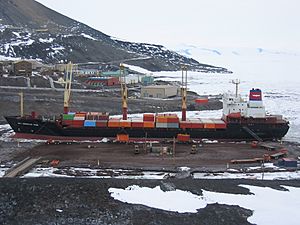Motor ship facts for kids
A motor ship is a type of ship that moves through water using an engine. Most motor ships use a powerful diesel engine to turn their propellers. You can often tell a motor ship by its name, which might start with MS or M/S. This stands for "Motor Ship." These ships are a common sight on oceans and rivers all around the world.
Contents
What is a Motor Ship?
A motor ship is basically any ship that uses an engine for power. Before engines, ships relied on wind (sailboats) or human power (rowboats). The invention of powerful engines, especially diesel engines, changed shipping forever. Motor ships can travel faster and more reliably than older types of ships. They do not depend on the wind or currents.
How Do Motor Ships Work?
Most motor ships use a diesel engine. Think of it like a very, very big engine you might find in a truck, but much more powerful.
- The engine burns diesel fuel to create energy.
- This energy turns a long shaft.
- The shaft is connected to a propeller at the back of the ship.
- As the propeller spins, it pushes water backward.
- This pushing action makes the ship move forward through the water.
Some larger motor ships might even use electric motors that are powered by diesel generators. This is called a diesel-electric system.
What Are Motor Ships Used For?
Motor ships are incredibly important for global trade and travel. They carry almost everything we use, from food to cars.
- Cargo Ships: These are the most common type. They carry goods across oceans.
- Container Ships: These carry large metal boxes called containers. Each container can hold tons of goods.
- Tankers: These ships carry liquids like oil, chemicals, or natural gas. They are built to safely transport these materials.
- Bulk Carriers: These carry loose cargo, such as grain, coal, or iron ore, directly in their large holds.
- Passenger Ships: These ships carry people.
- Cruise Ships: These are like floating hotels, taking people on vacations.
- Ferries: These carry people and sometimes cars over shorter distances, like across a bay or to an island.
- Specialized Ships: Many motor ships have unique jobs.
- Tugs: Small but powerful ships that push or pull other large ships in harbors.
- Fishing Vessels: Used for catching fish in large quantities.
- Research Vessels: Equipped with labs and tools for scientific study of the ocean.
The History of Motor Ships
The first motor ships appeared in the late 19th and early 20th centuries. Before that, steamships were popular. Steamships used large boilers to heat water and create steam, which then powered an engine.
- The first successful diesel-powered ship was the Vandal in 1903. It was a river tanker in Russia.
- The first ocean-going motor ship was the MS Selandia, launched in 1912. It was a Danish cargo and passenger ship.
The Selandia showed the world that diesel engines were reliable and efficient for long voyages. This led to many more motor ships being built.
Advantages of Motor Ships
Motor ships have several benefits compared to older types of ships:
- Efficiency: Diesel engines are very fuel-efficient for their size and power.
- Speed: They can travel faster than sailing ships and often faster than early steamships.
- Reliability: Engines provide consistent power, so ships are not dependent on wind or weather.
- Space: Diesel engines take up less space than steam engines and their boilers, leaving more room for cargo or passengers.


